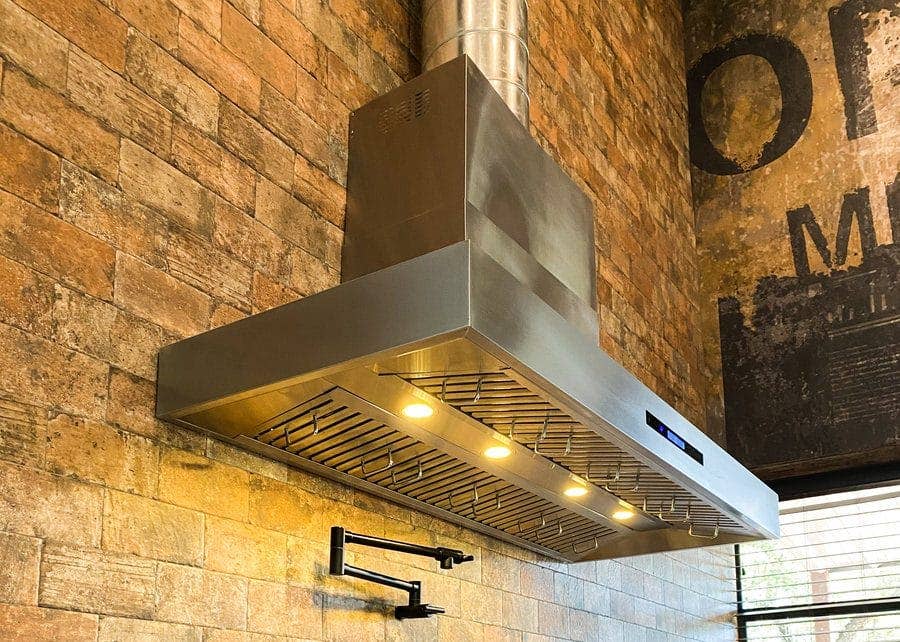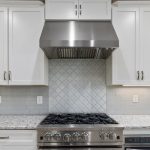To choose a range hood fan, consider the size and layout of your kitchen, the type of cooking you do, and the level of noise you’re comfortable with. Range hood fans come in various styles, sizes, and functions, so it’s important to choose the right one to ensure proper ventilation and air quality in your kitchen.
You also want to ensure that the range hood fan is easy to clean and maintain. A good range hood fan can help remove steam, smoke, and cooking odors while keeping your kitchen fresh and clean. In this article, we’ll go over the important factors to consider when choosing the right range hood fan for your kitchen.

Credit: www.prolinerangehoods.com
Types Of Range Hood Fans
When it comes to selecting a range hood fan, there are a few key factors you should consider, such as size, type, and airflow. Choosing the right range hood fan is crucial as it helps to keep your kitchen free of smoke, odours, and grease.
We’ll discuss the three main types of range hood fans: wall-mounted, island, and under-cabinet.
Wall-Mounted Range Hood Fans
Wall-mounted range hood fans are commonly placed above cooktops and are ducted to the outside of the house through the wall. Here are some key points to consider:
- Wall-mounted range hood fans are excellent at capturing smoke and fumes, making them ideal for heavy cooking.
- They come in different sizes and designs, so you can choose one that best suits your kitchen decor.
- Wall-mounted range hood fans require professional installation and may involve modifications to your home’s electrical and ductwork systems.
- They can be noisy, so look for models with quiet fans or variable fan speeds.
Island Range Hood Fans
Island range hood fans are installed on the ceiling above a cooktop situated on an island in the middle of a kitchen. Here are some things you should know:
- Island range hood fans require ductwork installed in the ceiling.
- They offer a striking design element to a kitchen and can be a great focal point.
- Island range hood fans come in different sizes and styles to match your kitchen decor.
- When choosing an island range hood fan, think about the ceiling height in your kitchen and the appropriate size for your island.
Under-Cabinet Range Hood Fans
Under-cabinet range hood fans are installed underneath a cabinet that sits above the cooktop, so it sits flush or is partially visible. Here are some key features of these range hood fans:
- They come in different sizes and styles, so you can find one that fits perfectly under your cabinet.
- Under-cabinet range hood fans do not require ductwork, which makes installation easier and less expensive.
- They work best for light to moderate cooking.
- They’re usually less expensive compared to other types of range hood fans.
Choosing the right range hood fan depends on your cooking style, kitchen design, and budget. Regardless of which type you choose, don’t forget to consider the size, filter type, airflow rating, and noise level while making your final decision.
Design And Style
Choosing The Range Hood Fan Size And Style
When it comes to choosing the right range hood fan for your kitchen, the size and style are two important factors to consider. Here are the key points to help you make an informed decision:
- Range hood size: Choose a range hood fan that matches the size of your cooktop or range. As a general rule, the hood should be at least as wide as the cooktop. If you have a larger cooktop, consider a range hood with a higher cfm (cubic feet per minute) rating.
- Hood style: There are various hood styles to choose from, including under-cabinet, wall-mount, island, and downdraft. Consider your kitchen layout and personal style when choosing the hood style.
Extractor Fan Noise Levels
Noise levels are an important factor to consider when choosing a range hood fan. Here are the key points to keep in mind:
- Cfm rating: Range hoods with higher cfm ratings tend to be louder than those with lower ratings, but they also provide better ventilation performance.
- Sones rating: Look for a range hood with a low sones rating (less than 6) for quiet operation.
- Ductless vs. ducted: Ductless range hood fans tend to be louder than ducted ones, but they are more versatile in terms of installation location options.
Energy-efficiency and keeping your kitchen healthy with the right range hood fan
Choosing an energy-efficient range hood fan can not only help reduce your energy bills but also keep your kitchen healthy. Here are the key points to keep in mind:
- Energy star rating: Look for a range hood fan with an energy star rating, which means it meets energy efficiency guidelines set by the us environmental protection agency (epa).
- Filter types: Choose a range hood fan with efficient filters that can trap airborne particles and grease.
- Ventilation system: Proper ventilation can help eliminate harmful pollutants from your kitchen, so choose a range hood fan with a ventilation system that suits your needs.
Exhaust Fans & Filters
How to choose a range hood fan: exhaust fans & filters
Range hood fans are an essential component of any kitchen, as they help to remove the smoke, steam, and odors that result from cooking. When it comes to choosing the right range hood fan for your kitchen, there are a few things you need to consider.
In this post, we will delve into understanding exhaust fans and filters in your range hood.
How To Choose The Right Fan Power
The power of the range hood fan is determined by the amount of cubic feet per minute (cfm) it can move. This cfm rating is dependent on the size of your kitchen, the layout of your stovetop, and the type of cooking you do.
Here are a few key points to consider when choosing the right fan power:
- For small kitchens, a 150-250 cfm range hood fan will suffice, whereas larger kitchens might need a more powerful hood fan with a cfm of between 300-900.
- If you are a frequent deep fryer, it’s recommended to go for a more powerful hood fan to expel more of the smoke/grease fumes.
- If your cooktop is located on an island, it’s advisable to consider an island hood fan with a higher cfm rating.
Understanding Different Types Of Filters
Range hood filters help to trap grease and other airborne particles and prevent them from escaping into the air. There are mainly three types of filters for range hood fans. These include:
- Mesh filters. These are made of multiple layers of aluminum mesh that traps grease and grime and can be washed using a dishwasher.
- Baffle filters. These filters are more efficient than mesh filters and are made of multiple layers of metal baffles. As air passes through the filter, the grease and smoke get trapped between the baffles. They are more long-lasting, but they need to be hand washed instead of running them through the dishwasher.
- Carbon filters. These are optional filters that help in removing the odors of cooking. These filters typically need to be replaced every couple of months, depending on usage.
Maintenance And Cleaning Tips
To ensure the longevity and optimal performance of your range hood filters, it’s essential to clean them regularly. Here are a few maintenance and cleaning tips to consider:
- Clean your range hood filters every month by soaking them in hot water mixed with a degreasing solution. Rinse thoroughly and air-dry before reattaching them.
- If you are using mesh filters, you can clean them by placing them in the dishwasher on the top rack.
- Check for cracks or any other damage to the filters while cleaning them.
- If you have a ducted range hood, inspect the ductwork every year and clean it if needed.
Choosing the right exhaust fan and filter for your range hood is a crucial aspect of creating a clean and healthy kitchen environment. By considering the size of your kitchen, the layout of your stovetop, and the type of cooking you do, you can make an informed choice regarding the right fan power.
Additionally, understanding the different types of filters and following the recommended cleaning and maintenance tips can help extend the life of your range hood fan and ensure that it continues to operate at optimal performance.
Installation And Maintenance
Diy Or Hiring A Professional?
Installing a range hood fan can be a daunting task, especially if you lack the experience and expertise required to handle it. It might be tempting to take the diy route to save some money, but it can be risky.
That said, here are some essential things to keep in mind when choosing between doing it yourself or hiring a professional.
- Diy: If you choose to install the range hood fan by yourself, do proper research beforehand. Watch online tutorials, read the manual thoroughly, and take all the necessary precautions, such as turning off the power supply. Also, ensure that you have all the required tools and materials. Lastly, avoid proceeding if you are not entirely sure about what you are doing.
- Hiring a professional: This is a safer and more convenient option. Hiring a licensed contractor experienced with range hood fans installation can save you time, energy, and the risk of costly mistakes. They know how to work with different models, will ensure proper installation, and have the necessary tools, materials, and safety equipment to complete the job efficiently.
Pre-Installation Checklist
Prior to installing your range hood fan, there are some necessary preparations you need to make. Here is a checklist of things to keep in mind:
- Check the ceiling height and the hood fan dimensions to ensure compatibility.
- Confirm the exhaust duct’s length, material, and size, which should be in line with the manufacturer’s recommendations.
- Select the right location and mark the spot where you wish to mount the hood ensurer proper clearance above the cooktop surface.
- Locate and outline the position of the vent on the wall or roof. Be mindful of any obstructions and ensure a clear airflow path.
- Read the product manual carefully and gather all the necessary tools and hardware
Cleaning And Maintenance Tips
Proper maintenance of your range hood fan is essential for its longevity and efficient performance. Here are some cleaning tips to keep in mind:
- Regularly clean the fan blades or filters every 2-3 months. This frequency is based on how often you use the range hood fan.
- Clean the exterior surface with mild soap and a non-abrasive cloth to avoid scratching the stainless steel.
- Ensure that the exhaust vent is free from obstructions such as dust, grease or debris. This increases the range hood’s efficiency; preventing it from making loud noises.
- Replace filters as required. Consult the product manual for specific information on when and how to replace filters.
Choosing the right range hood fan is the first step for a safe and efficient kitchen ventilation system. Whether you decide to go the diy or professionals route on installation, maintenance is a vital step to ensure the longevity of your range hood fan.
Follow our guide, and you are on your way to having a clean, safe, and well-ventilated kitchen.
Frequently Asked Questions On How To Choose A Range Hood Fan
How Do I Know What Size Range Hood Fan I Need?
A range hood fan should have a minimum capacity of 100 cubic feet per minute (cfm) for every 12 inches of stove width. For example, a 30-inch stove needs a fan with a minimum capacity of 250 cfm. You can also consult with a professional or use online calculators for a more accurate estimation.
What Types Of Range Hood Fans Are Available?
The main types of range hood fans are under-cabinet, wall-mount, island-mount, and downdraft. Under-cabinet hoods are installed beneath a cabinet above the range, while wall-mount hoods attach to the wall above the range. Island-mount hoods are installed above a range on an island in the kitchen, and downdraft hoods are installed behind or to the side of the cooking surface.
What Type Of Range Hood Fan Is Most Appropriate For My Kitchen?
Consider the type of range you have when selecting a hood. A downdraft hood is ideal if you don’t want anything visible above the range. An island-mount hood is perfect for an island range. A wall-mount hood works best if you have a range located against a wall.
An under-cabinet hood is suitable if cabinet space exists above the range.
How Do I Choose The Right Fan Speed For My Range Hood Fan?
It is important to use the right fan speed level for your cooking needs. A low setting is ideal for simmering, while a medium setting is good for stir-frying or sautéing. A high setting is best for boiling or frying.
Choose a range hood fan with multiple speed settings for versatile use.
What Are The Key Features To Consider When Choosing A Range Hood Fan?
Look for a fan with high cubic feet per minute (cfm) rating, multiple speed settings, and noise level. Additionally, consider the design and style of the hood, the type of filter it uses, and the material used to make it.
Some hoods also have additional features like lighting or a heat sensor.
Conclusion
Choosing the right range hood fan is crucial for maintaining a healthy and comfortable home. It is important to consider the size of your cooking area, your cooking habits, and the noise level of the fan before making a decision.
Remember to pay attention to the air flow capacity and the fan’s efficiency in extracting smoke, grease, and odor from your kitchen. Don’t forget to also factor in the overall design and aesthetics of the range hood fan and whether it matches your kitchen decor.
With these considerations in mind, you can confidently make an informed decision that will serve you for years to come. We hope this guide has been helpful to you in your search for the perfect range hood fan.

Freda is a passionate foodie and kitchen gadget enthusiast. With over 10 years of experience in the culinary industry, Freda brings her expertise in testing and reviewing kitchen gadgets.




